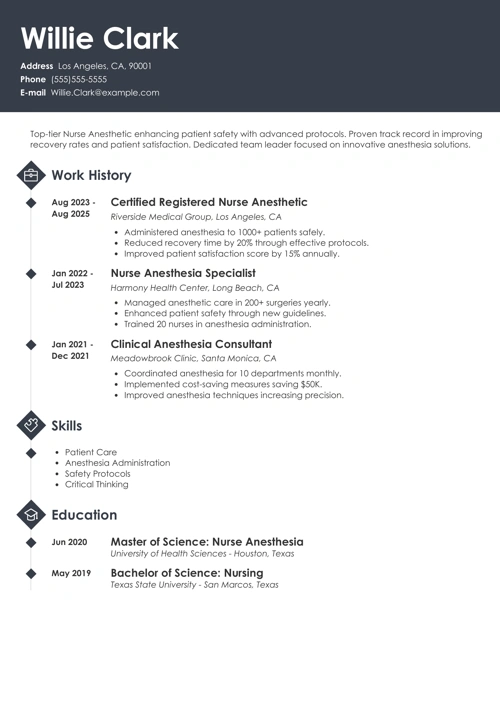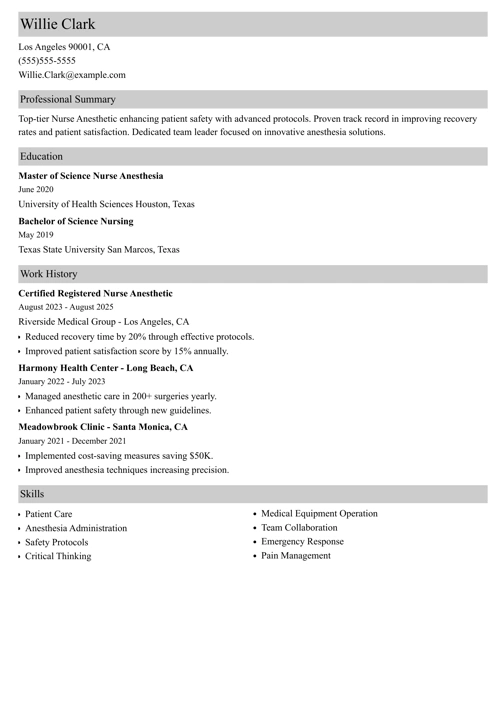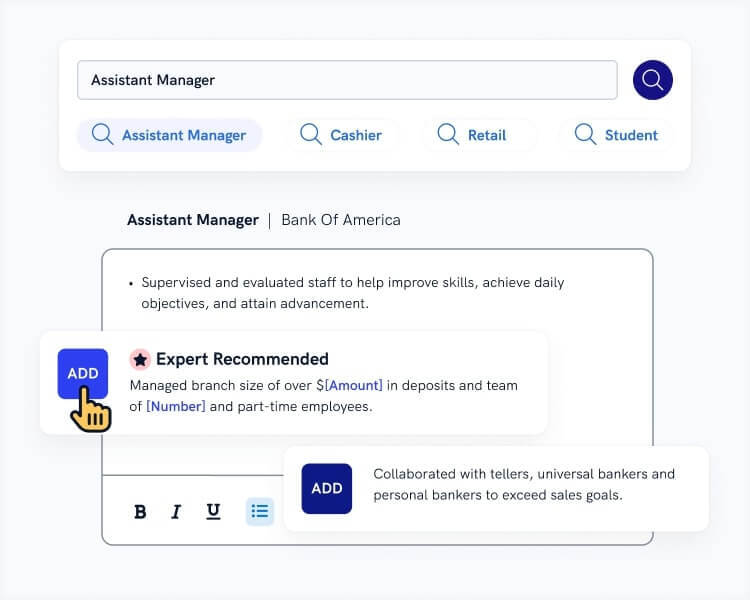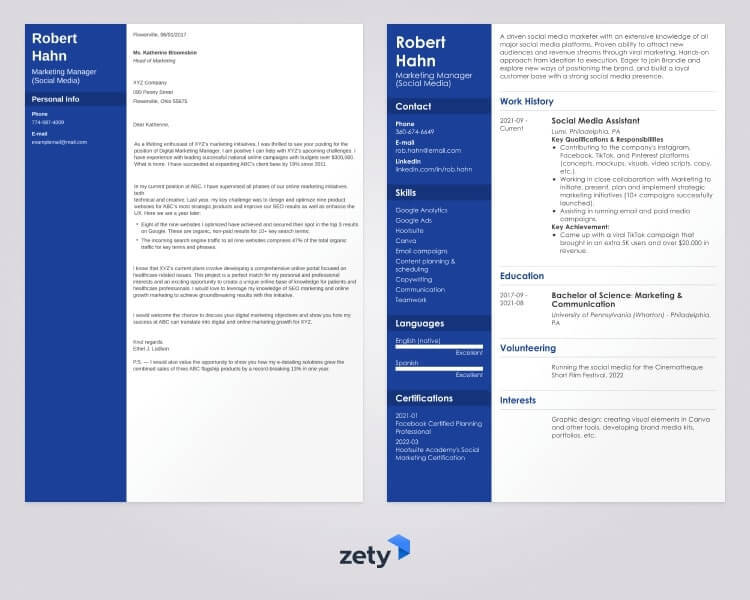You do way more than apply anesthetic. Your role is critical in ensuring the patient’s safety during any given procedure—that says more than any job title ever could.
And even though laughter may be the best medicine, certainly having your CRNA resume laughed out ain’t exactly a great career goal. Let’s make sure recruiters don’t go into a coma here, shall we?
This guide will show you:
- A CRNA resume example better than 9 out of 10 other resumes.
- How to write a CRNA resume that will land you more interviews.
- Tips and examples of how to put skills and achievements on a CRNA resume.
- How to describe your experience on a resume for a certified registered nurse anesthetist to get any job you want.
Want to save time and have your resume ready in 5 minutes? Try our resume builder. It’s fast and easy to use. Plus, you’ll get ready-made content to add with one click. See 20+ resume templates and create your resume here.
Sample resume made with our builder—See more resume examples here.
One of our users, Brittanya, had this to say:
Zety really helped me create the best resume possible. It pointed out how things could be better on my existing resume and suggested many things to be re-worded or removed.
Interested in other nursing positions? See these:
- CNA Resume Examples
- Nursing Resume Examples
- Caregiver Resume Examples
- Medical Assistant Resume Examples
- Nursing Student Resume Examples
- Med-Surg Nurse Resume Examples
- Charge Nurse Resume Examples
- Pediatric Nurse Resume Examples
- OR Nurse Resume Examples
- ICU Nurse Resume Examples
- Registered Nurse (RN) Resume Examples
- Healthcare Resume Examples
Certified Registered Nurse Anesthetic Resume Example
Willie H. Clark
CRNA
570-879-8729
Williamclark@gmail.com
Summary
Motivated CRNA with 4 years of experience. Skilled in administering various types of anesthesia for surgical procedures. Maintained a 90% patient satisfaction rate for providing post-op pain management and follow-up care. Was #1 most called for CRNA in the OB/GYN wing of Golden Hawk General Hospital.
Work Experience
CRNA
Duke University Hospital, Durham, NC
May 2020–Present
- Conducting pre-operative patient assessments to determine appropriate anesthesia plans and identify potential risk factors, decreasing the frequency of complications during procedures by 25%.
- Administering anesthesia for surgical procedures, including orthopedic, neurosurgical, and cardiovascular surgeries, with a 98% success rate.
- Collaborating with the rest of the anesthesia team to develop and implement individualized anesthesia plans.
- Monitoring patient vitals during procedures and adjusted anesthesia levels as necessary to maintain patient safety and comfort, slashing occurrences of PONV by a third.
Assistant Nurse Anesthetist
St. David's Medical Center, Austin, TX
July 2017–May 2019
- Documented and maintained patient records.
- Responded to emergency situations, displaying composure and the ability to listen to the head CRNA.
- Collaborated with other anesthesiologists in a 350-bed facility to provide the highest quality care.
Education
2018–2020 MS,Nursing
Duke University School of Nursing, Durham, NC
2012–2016 BS,Nursing
University of Texas at Austin
Skills
- Selecting correct anesthesia
- Care planning
- Collaboration skills
- Electronic medical records (EMR) & documentation
- Problem-solving
- Attention to detail
- Anesthesia equipment & tech
- Communication skills
Certifications
- Certified Registered Nurse Anesthetist (CRNA), License Number #7532673824
- Basic Life Support (BLS)
- Advanced Cardiac Life Support (ACLS)
Other
- Member of the American Association of Nurse Anesthetists (AANA)
- Advanced proficiency in Spanish
Here’s how to write your own Certified Registered Nurse Anesthetic resume:
1. Choose the Best CRNA Resume Format
As a Certified Registered Nurse Anesthetist (CRNA), you ensure smooth operations in the operating room. Being well-oriented in patient safety, comfort, and emergency procedures is essential for a good CRNA resume.
And just as you provide a seamless transition into the sweet realm of dreams to your patients, so should you provide a seamless reading experience for potential employers.
How? By perfecting the structure of your resume.
- Start with clear and concise contact information in the header of your resume.
- Organize your experience in reverse chronological order. This will help hiring managers follow your career progression.
- Choose alegible resume font that is easy on the eyes, like a prescription not written by an MD.
- Use headings and proper resume formatting to create a visual hierarchy, guiding the reader's focus to your most significant achievements and experiences.
- Leave white space to make your resume look neat and organized.
- Aim to fit everything on a single page.Two-page resumes just don’t cut it 95% of the time.
- Save your resume as a PDF to prevent formatting issues, much like how you prevent complications during anesthesia administration.
Read more: Full Guide to Resume Formats
2. Choose a CRNA Resume Summary or Resume Objective
Can’t count on a recruiter to give your resume much time. Give them something quick and easily scannable. Can you even make a CRNA resume stand out this fast?
Definitely, if you start with a clear and concise resume introduction statement. Otherwise, they have no reason to make way for you. With 2,400 new CRNAs entering the field each year, that’s quite some competition you’ll be up against.
As a CRNA, you can choose between aresume objective or aresume summary. If you're a newbie, go with the objective and highlight your knowledge and transferable skills that can be applied in the medical field.
If you're a seasoned CRNA with over 2 years of experience, show off your experience like a true boss with the summary. Add some numbers to back it up.
Pro Tip: Feeling some brain fog here? If writing the start of your resume has got you feeling as if you put yourself under, tackle the other sections of your resume first and come back to this part later.
3. Mention Relevant Experience in the Work History Section of Your CRNA Resume
There’s one particular side effect of anesthesia you might not be familiar with, seeing as it’s not medically induced. At least that’s what happens when you turn your CRNA resume into a weaponized recruiter anesthetic.
Most likely, this happens inadvertently, so read on to see if you’re guilty of any of these:
- Start your work experience section with your most recent. It's called reverse chronology.
- Include your job title, the company or hospital name, the years you worked there, and 5–6 bullet points highlighting your responsibilities and duties.
- Use action words, numbers, and percentage values, and stick to relevant experience only.
- Once that’s done, give the section another look and make sure you’re tailoring your resume to the needs of the hospital, clinic, or practice.
Read more: Irrelevant Experience: When Is It Good to Use?
4. Sort Out Your Education in a Resume for a Certified Registered Nurse Anesthetic
7 to 8 years. That’s what it takes to become a CRNA. Emphasis on the C.
Why would the thought of not including education on your resume even cross your mind?
Keep it simple by listing:
- The name of the school you attended
- The degree you earned (including any majors or minors)
- The year you graduated
It's that easy. Of course, if you want to throw in some extra credit by mentioning your stellar GPA or relevant coursework, go for it. But don't let it steal the spotlight from your impressive work experience and skills.
Read more: Surgical Tech Resume [Samples for Technologist & Technician]
Creating a resume with our builder is incredibly simple. Follow our step-by-step guide and use content from Certified Professional Resume Writers to have a resume ready in minutes.
When you’re done, Zety’s resume builder will score your resume and our resume checker will tell you exactly how to make it better.
5. Select the Right Skills on Your CRNA Resume
If you know the difference between regional, general, and MAC, the head surgeon must know you’ve got that skill.
In other words, you don't want to be caught with your scrubs down and not list skills that you have. Conversely, bending the truth on your resume and listing skills you can’t actually perform is no good either—that's just asking for trouble.
The best way to add skills to your resume is by doing some detective work. Take a good look at the job posting and try to match the specific skills they’re looking for.
Just pay attention to the details. The ad likely was created with specific keywords in mind, and those will sync up with their Applicant Tracking Systems.
So, if they want someone who's “organized, compassionate, and skilled in medical terminology,” make sure those skills and/or descriptions make your way onto your resume.
Best Skills to List on CRNA Resume
- Administering Anesthesia (TIVA/MAC/General/Regional/Local)
- SpO2, EKG, PEEP Monitoring
- Pharmacological Expertise
- Operating Anesthesia Equipment
- Airway Management Procedures
- Pain Management
- Anesthetic Emergency Response
- Documenting Patient Data
- Preliminary Evaluations
- Strong Communication Skills
- DVT Identification & Response
- Active Listening
- Empathy
- Collaboration Skills
- Adaptability
- Attention to Detail
- Critical Thinking
- Sensitivity to Patient Needs
- Professionalism
- Clinical Judgment
- Decision-making
- Knowledge of Anatomy, Physiology & Pharmacology
- Math Skills
- Organizational Skills
- Physical Dexterity
- Hand-eye Coordination
- Healthcare Regulations
- Patient Safety Standards
- Patient Rights
Read more: What Skills to Put on a Resume
6. Add a Bonus Section to Your CRNA Resume
CRNAs are the superheroes of the operating room, the caped crusaders of anesthesia, but if your resume doesn’t accurately reflect that, you’ll just be another masked face in the room.
Showcasing additional facets of your professional activity can be the difference maker between getting hired and getting mistaken for an imposter.
That’s why adding your CRNA certifications or licensure,volunteer work in healthcare, hobbies and interests, or spoken foreign languages could make you stand out from the pack. Use it to display some extra passion about your own job.
Read more: Steps to Improve Your Resume (That You Probably Don’t Know)
7. Include a Cover Letter with Your CRNA Resume
Note this: you should write a cover letter. You won’t receive any informed consent regarding what might happen if you don’t write one. Unfortunately, recruiters aren’t just that magnanimous.
But if you take a look at our statistical reports, lots of hiring managers expect to see one.
Not sure what a cover letter should look like? Here’s a quick refresher:
- Make sure your cover letter looks sharper than a scalpel by using the correct cover letter format.
- Start strong with a cover letter opening that grabs their attention like a pair of surgical forceps.
- Tell them why you're the perfect fit for their medical facility. Think of their values, spotless record, or reputation, and demonstrate how you fit in.
- Using specific examples of past work with numbers on your cover letter works wonders.
- End your cover letter with a strong call to action that leaves no doubt that you're the CRNA they need. For bonus points, a post-script will stick in their mind—it’s the ace up your sleeve. Definitely use it.
Plus, a great cover letter that matches your resume will give you an advantage over other candidates. You can write it in our cover letter builder here. Here's what it may look like:
See more cover letter templates and start writing.
About Zety’s Editorial Process
This article has been reviewed by our editorial team to make sure it follows Zety's editorial guidelines. We’re committed to sharing our expertise and giving you trustworthy career advice tailored to your needs. High-quality content is what brings over 40 million readers to our site every year. But we don't stop there. Our team conducts original research to understand the job market better, and we pride ourselves on being quoted by top universities and prime media outlets from around the world.




